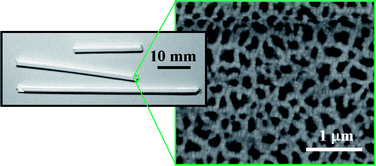An attempt was made to synthesize a large-size silica porous monolith with straight and parallel nanochannels using an ice-rod nanoarray as a template. Since the previously reported ice templating methods allowed only the formation of micrometer-sized channels, special efforts were made to decrease the channel size down to the nanometer scale. Furthermore, such nanoporous silica monoliths were prepared not from an often-used and unstable hydrogel but from a stable colloidal silica solution. By increasing both the ice growing rate and the temperature gradient in the ice–water interface as much as possible, the channel size was reduced to 530 nm. Moreover, with the addition of the water-soluble polymers such as γ-cyclodextrin and dextran, the channel size was further decreased. Finally, using dextran polymer, the channel size reached as small as 180 nm, which is close to the theoretical lower limit (120 nm) in the present silica solution. This noticeable effect of the polymers may be explained from their strong interaction with water molecules through hydrogen bonding, but the most necessary condition for the polymers is that they never induce the aggregation of the silica particles in the solution. The methodology of obtaining much narrower channels using the ice templating method was discussed on the basis of the present results.

You have access to this article
 Please wait while we load your content...
Something went wrong. Try again?
Please wait while we load your content...
Something went wrong. Try again?


 Please wait while we load your content...
Please wait while we load your content...